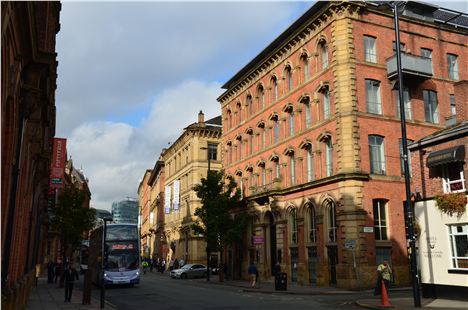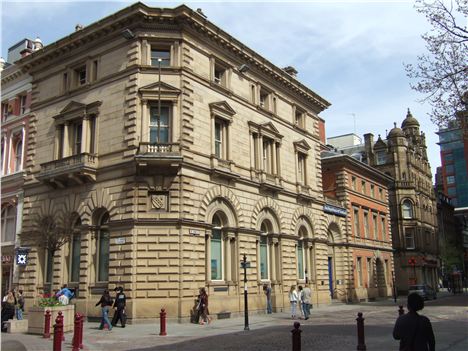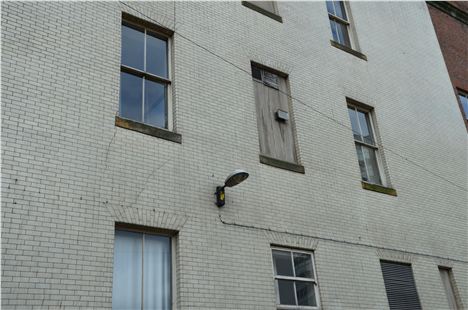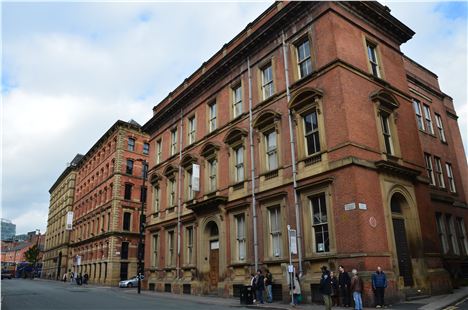Category: Excellent
What?
The Mechanics Institute, Princess Street, city centre. And here's their website.
When?
1856
Who?
John Edgar Gregan
Why’ve you picked this building?
Loads of reasons. But first because it’s an excellent building. It’s in the palazzo style (click here for an explanation of this), three storeys, brick with stone dressings and has the rhythmic close spacing of windows seen in the surrounding warehouses, but the detailing is crafted more carefully. It’s strong but not flashy; a classic and classy city structure. Round the back it’s plainer, with a wall of white tiles to provide extra light on what would have been a very narrow and dark street.
Palazzo style and a bus
What did it have inside?
The Mechanics’ Institute had been created in 1824 with philanthropist money. The first president was Benjamin Heywood, a prominent banker. Gregan had already designed Heywood’s Bank in St Ann’s Street in 1846 which is maybe why he was chosen for this commission when the Institute moved to purpose built premises. Heywood’s Bank is the most exquisite ‘palazzo’ of them all and a triumph of Manchester architecture. It’s now a Royal Bank of Scotland branch.
Gregan's perfect 'palazzo'
So what did the Mechanics do?
The Institute promoted adult education in the sciences and the arts for those who may not have had access to a full education. The Princess Street building had a newspaper and reading room, classrooms, catering facilities and a ‘Great Hall’ for debates.
White tiles for extra light round the back
Any other gems of history?
Absolutely. It was in this building that the TUC was founded in 1868. By Tories.
Tories....eh?
It’s an irony that given the future links between the Labour Party and the Trades Unions that two prime movers and shakers behind the first ever Trades Union Congress, William Wood and Samuel Nicholson, were both Conservatives. They helped set up the Manchester Salford and Trades Council, a body, that in February 1868 called for a national congress aimed at addressing the ‘profound ignorance which prevails in the public mind’ about unions. This followed violent trade disputes in the Sheffield cutlery industry, amongst Manchester’s bricklayers and elsewhere. The first meeting called for annual congresses, for ensuring that unions are ‘an absolute necessity’, and debated the ‘inequality of law in regard to intimidation picketing, coercion’ and the need for government inspection into conditions of work. And then there’s Francis Fukuyama.
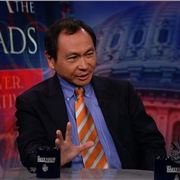 Mr Fukuyama gets it wrongWho he?
Mr Fukuyama gets it wrongWho he?
He’s the man who wrote a book called The End of History in 1989. He wrote, ‘What we may be witnessing is not just the end of the Cold War, or the passing of a particular period of postwar history, but the end of history as such... That is, the end point of mankind's ideological evolution and the universalization of Western liberal democracy as the final form of human government.’
That’s a big statement.
It is. I helped host his final meeting on his world tour promoting the book. We decided to host it in the main hall at the Mechanics. It seemed appropriate for the man who’d decided that socialism was dead. More than 200 people turned up. It looked like the entire population of one of the squats in a Hulme Crescent. They were all socialists, Marxists, communists - possibly there were some anarchists. Poor Fukuyama got metaphorically torn to shreds and trampled on. There wasn’t a single voice raised in support of his End of History idea.
Did he cry?
No, but later when we went to the Yang Sing for a dinner, he said, “I’ve been round the whole of the globe, through the former Eastern Bloc and everywhere, and never met such ideologues for the Left as I have in Manchester. I suppose that’s because you’ve never had a proper revolution nor been defeated in a war of occupation. You still look at Communism with rose tinted glasses.”
Anything else?Yes, in 2008 twenty four would be tour guides for Manchester, Green Badge Guides, sat exams in the main hall at the Mechanics. One of the questions was, ‘When was the TUC founded in Manchester?’ On a lectern at the front of the hall it said ‘TUC founded here in 1868’. Some of the guides missed it unfortunately: but they all passed. Despite the decor.
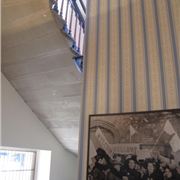 Brothel-chicWhat do you mean?
Brothel-chicWhat do you mean?
The 1980s fit out (I think that is when it dates from) has left some shocking wallpapers and partitioning. The stuff on the lift, next to a wonderful grand staircase you could ride a horse up, looks like something from a 1980s brothel.
Last thing, what goes on there now?
Well firstly we should be thankful for a campaign by concerned left-wingers such as Dave Carter, boss of the Manchester Digital Development Agency, that led to the building’s survival. It nearly went in the seventies and eighties, part of a crazed inner-ring road scheme. It's a meeting space and conference centre with function rooms where you can get married or talk about the broad sweep of political history. But more than that the Mechanics’ Institute is a special component of what makes Manchester, both in spirit and design.
The Mechanics Institute
You can follow Jonathan Schofield on Twitter @JonathSchofield or connect via Google+ Jonathan Schofield, in part association with Manchester Confidential, has written a new guide to the city. Click here.








